
When a client asked me to rehabilitate their cabin deep in the woods, I didn’t expect to step into a slaughter scene—of sorts. After a long, dusty drive down a back road, I reached a little house by a lake, retrieved the key from a lockbox, opened the front door, and was greeted by a cloud of bees. I slammed the door shut and called my client, explaining there was no way we could start work until the bees were gone. Unfortunately, someone had already tried the standard DIY solution of unleashing an insect bomb; the floor was littered with honeybee corpses.
Bees are important and should be protected
We live on a planet with some nine million species, yet many scientists consider the honeybee to be the most important species on Earth due to its role in pollinating plants and keeping ecosystems healthy. The human diet relies on crops that require bee pollination—no honeybees, no food. This underscores the seriousness of their declining populations due to factors like pesticides and habitat loss, raising concerns about food security. While killing honeybees is not unlawful, it does feel like a crime against nature.
For this reason, I think anyone who might uncover a colony in the course of their professional work has a responsibility to do right. Here I will share proper bee remediation protocol that can help protect this ecologically vital species.
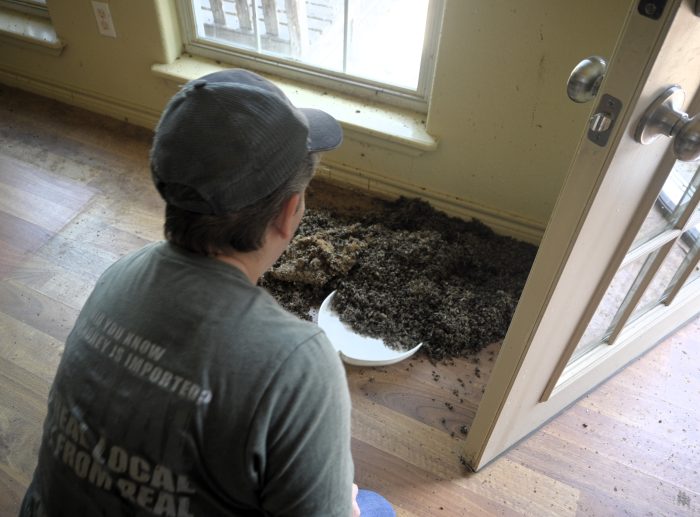
A colony situation
In the case of my client’s house, I knew honeycombs were likely hidden behind the drywall. Unless we removed these, a sticky situation would remain and attract other creatures as well as remnants of the original bee colony.
A single colony can have as many as 80,000 bees, making it difficult to eliminate all of them. They find a way back. Block one entrance, and they’ll find another—even chewing through wood and plaster if necessary. So-called robber bees can come to steal honey from the weakened colony. New swarms may move in, and dead bees will begin to stink. If bees die in hidden places, the pungent stench hangs around for many months.
Secure the right professional
I knew this was a job for a bee professional. After a few inquiries, I found Nanette Davis, a master beekeeper at Garden Variety Bees. She agreed to look at our situation. We met a few days later, and she was shocked. “I’ve never seen so many dead bees,” she remarked. “This was once a massive colony.”
Nanette used a thermal imaging camera to look for a heat signature and determined the hive was in the ceiling. We agreed to wait until the weather cooled so the bees would be calmer, and the work would be less uncomfortable—the house is in Houston and has no air conditioning.
A few weeks later, Nanette returned with her assistant, Scott Davis. They arrived on the job site like any other subcontractor, unloading ladders and other equipment. Their tools included hive boxes with frames to move panels; bee vacuums to safely extract the insects; hive tools that resemble paint scrapers; buckets; a bee smoker; and protective jumpsuits, gloves, and veils, with extras for my crew.
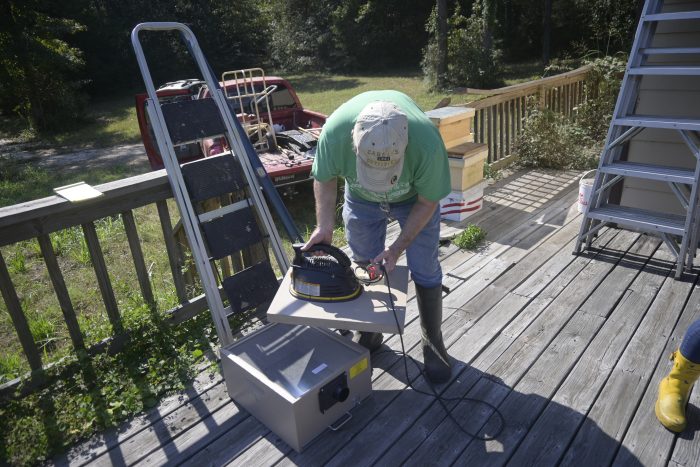
Beekeepers work under many regulations and registrations to ensure public safety while removing bees. In Texas, pending legislation proposes mandatory training and licensure for a “Bee Removal Professional.” It’s a serious trade. But beekeepers aren’t authorized to perform demolition work in many areas.
Opening up a ceiling isn’t a big deal for a contractor like me but in the bee business, where the beekeeper may know little about building hazards like electrical wiring or plumbing, cutting into a house is not part of their job. Laws vary across jurisdictions, so it’s always best to hire a professional with the right equipment and knowledge to follow any mandated protocols; and a licensed building professional should always be the one to open building components for access to the hive.
Extracting the hive
I set up the ladders and drilled a few holes into the ceiling. Nanette used a fiber-optic inspection camera to confirm the hive’s precise location. Fully suited, I climbed the ladder, jab-saw and a battery-powered Sawzall in hand, and began careful demolition.
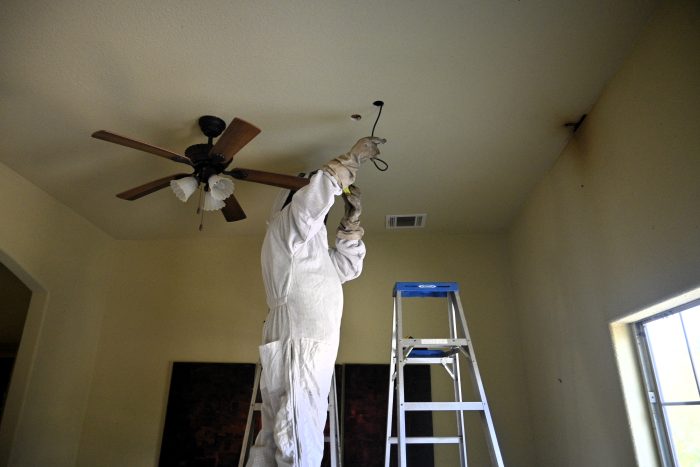
As the drywall came off, I got my first glimpse of the hive. It didn’t look as I expected. Honeycombs are often suspended vertically—in this case, from under the subfloor of the second story. Initially, I thought it was foam insulation. Looking closer, I saw the hexagonal structure of the individual cells; bees construct hexagons because this shape fits together perfectly, without leaving voids between cells. At this point, it was time to let the expert take over.
Though we had exposed the hive and shaken the structure while cutting, the bees were surprisingly calm. While there are around 4,000 native bee species in the United States—800 of them in Texas—there was no doubt about the species here: Western honeybee, Apis mellifera, the only bee in the country that produces honey. And there was plenty of it. As Nanette scraped each subfloor panel, honey poured down her hands and arms onto the ladder rungs and the floor. It’s a sweet but messy job!
After removing the panels, they were cut and placed in a wooden frame and secured with rubber bands. These frames slipped into a slotted box for transportation. Once all the panels were safely removed, Nanette scraped all the wax and honey from the underside of the joists because any remaining trace of honey would bring the bees back.
With the hive gone, I could see where the bees had entered through a gap between the joists and the floor framing. They built their hive in the spot where the builder didn’t fill the joist bay with insulation. I caulked this crack and made a mental note: always seal around joists and never forget to insulate.
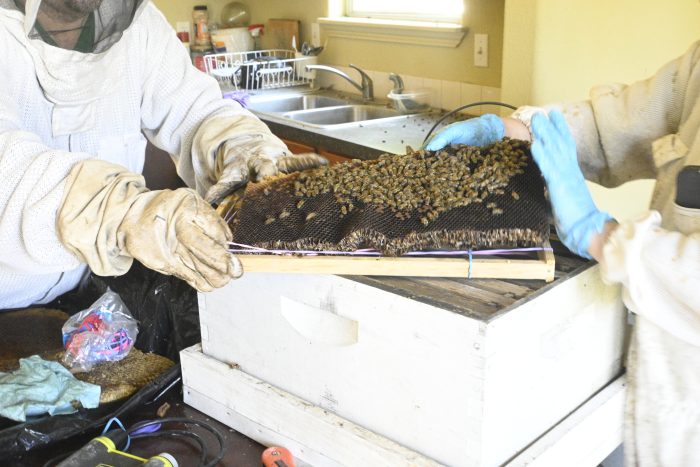
Spray paint was used to seal the wood framing and kill any remaining odor. Odor-blocking paints, such as BIG D Odor Eliminator and KILZ, that are used in restoration work following smoke damage work better than standard sprays.
To finish the extraction, Scott used a “Colorado Bee Vac” to gently suck the bees through a tube into a ventilated screened box. It seemed like an endless task; as bees were removed, new ones flew into the house through cracks. Eventually, the panel box and the rest of the equipment were loaded onto the truck, and we were ready to move the bees to their new location.
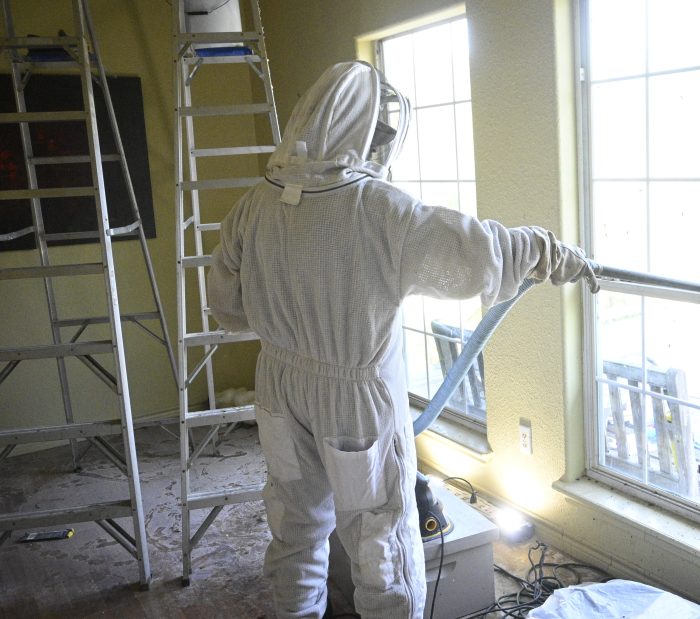
We followed the beekeepers to a field where several hives were stacked on trailers, raised above the ground to protect them from flooding. The pair suited up again, as dropping bees into their new home can cause anger and swarming.
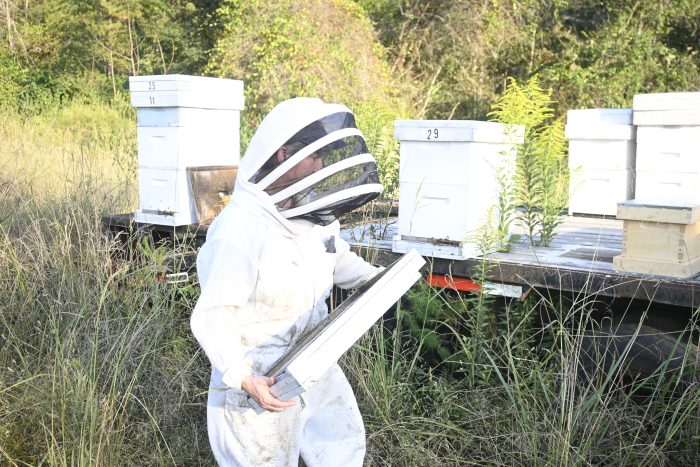
Structural concerns from hive infestation
Honeycombs hidden within walls or ceilings can cause structural damage. Honey and wax seep into wood framing, creating potential mold growth and wood rot, while inviting rodents or secondary insect infestations. Over time, the added weight and moisture within walls can compromise the integrity of insulation, drywall, and even electrical components.
Post-removal repairs and restoration
Following hive removal, restore affected areas by thoroughly scraping any wax or honey residue from wood framing, applying an odor-blocking paint, re-insulating cavities, and repairing drywall or wood as necessary to prevent future infestations. Properly closing entry points near joists or framing will bee-proof the area and protect against new colonies.
Bear in mind
Honeybees may occasionally nest in walls or attics, but their ecological value and the temporary nature of their hives make them worth relocating. Contractors should avoid extermination when dealing with bees. While exterminators might offer a quick solution, they don’t address the root issue—bees will reestablish their hives. A green builder is one who respects ecological balance and seeks sustainable solutions. So, plan for responsible hive removal. It supports environmental health and aligns construction best practices with a commitment to eco-conscious values.
_______________________________________________________________________
Fernando Pagés Ruiz is a builder and an ICC-certified residential building inspector active in code development. Images courtesy of author, except where noted.
Weekly Newsletter
Get building science and energy efficiency advice, plus special offers, in your inbox.











5 Comments
Very interesting! I've never had to deal with something like that but now I know what to do if that situation arises.
Killing honeybees is indeed a crime against nature. I like that you didn't say "the most important species after humans." I'd argue that considering declining populations of beneficial insects and birds worldwide, that killing any beneficial insect is criminal. We grow about a half-acre of insect habitat on our land and love seeing the biodiversity that has resulted.
I have to offer a bit of a Contrarian take here. I've kept honeybees, they aren't wild animals. They are domesticated livestock. They do escape and can reproduce in the wild, but they reproduce most readily in captivity. There was a whole lot of press about ten years ago about "colony collapse disorder" that completely missed the point that these are domesticated animals, not some wild endangered species.
While they are not particularly important pollinators in the scheme of things, they are important for agriculture because they enable monocultures. A hive can be brought into an orchard when it is in flower and then moved to the next orchard, during pollinating season places like California's Central Valley have tractor trailer loads of bee hives following the bloom as it moves north. If you relied entirely on native pollinators you could never have that many trees blooming at the same time in the same place, they'd starve once the blossom stopped. Whether enabling monocultures is good or not for the environment is a controversial issue and a question for another day.
A hive like this is probably worth a few hundred dollars, about the same as a small animal like a goat or a suckling pig. A hive that has been treated with pesticide is probably worthless, there's no way of knowing if the honey has been contaminated. While rescuing a hive feels good -- I've done it a couple of times myself -- let's not exaggerate the impact.
DC,
A fascinating post about something I understood very little about.
And honeybees are not native to the Americas, either! Brought here by European colonists in 1622.
They are indeed livestock but humanity has "evolved" to rely on the type of agriculture they pollinate. My wife and I grew large, diverse gardens for many years, without raising bees, relying on natural pollination. There were several reasons we stopped, but the lack of effective pollinators--wild or domesticated--was one.
Log in or create an account to post a comment.
Sign up Log in